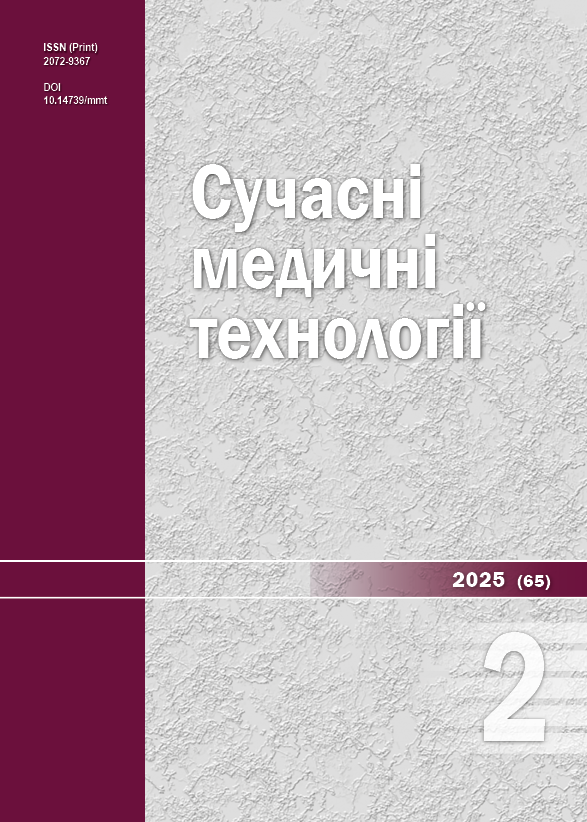The clinical role of daily blood pressure monitoring for the management of patients at the ambulatory stage
DOI:
https://doi.org/10.14739/mmt.2025.2.324147Keywords:
hypertension, ambulatory blood pressure monitoring, ambulatory blood pressure system, white coat hypertension, masked hypertensionAbstract
The aim of the work is to analyze and evaluate the clinical role of daily blood pressure monitoring for the management of patients with arterial hypertension.
Materials and methods. We analyzed the scientometric databases Scopus, Web of Science, PubMed and conducted a retrospective analysis of literature sources for 2019–2024. The most relevant sources on this topic were selected for analysis. Based on the review of article abstracts and their full text, 29 sources were selected.
Results. Blood pressure (BP) measured by the method of ambulatory blood pressure monitoring (ABPM) provides prognostic information about cardiovascular disease to a greater extent than “office blood pressure” and is more associated with predicting cardiovascular risk. The most clinically important are 24-hour and nighttime BP levels, while other BP indices, in addition to 24-hour and nighttime BP levels, contribute little to risk stratification or treatment of hypertension. ABPM provides a more physiologically accurate measurement of “true” blood pressure and its changes during the day. In most cases, values are considered normal if the 24-hour average BP is 130/80 mm Hg or less, daytime BP is 135/85 mm Hg or less, or nighttime BP is 120/70 mm Hg or less. The European guidelines for the treatment of hypertension support the use of out-of-office BP measurements to confirm the diagnosis of hypertension and to identify hypertension phenotypes such as “white coat” hypertension and masked hypertension. White-coat hypertension is associated with an increased long-term risk of persistent hypertension and mortality, so patients at high risk of cardiovascular disease should be treated with pharmacological therapy along with nonpharmacological approaches. Masked hypertension carries a risk, adjusted for many factors, almost equivalent to resistant hypertension. There are 3 subtypes: masked effect, masked hypertension, and masked uncontrolled hypertension. It is advisable to consider pharmacologic treatment in patients with masked hypertension after treating risk factors such as obesity, diabetes, alcohol consumption, smoking, and stress.
Conclusions. The main contribution of ABPM to the diagnosis and treatment of hypertension is the cross-classification between office and ambulatory BP measurement. Current data suggest that 24-hour ABPM should be an integral part of the management of patients with hypertension.
References
Ministry of Health of Ukraine. [Unified clinical protocol for primary and specialized medical care. Hypertensive disease (arterial hypertension)]. Order dated 2024 Sep 12, No. 1581 [Internet]. 2024 [cited 2025 Feb 3]. Ukrainian. Available from: https://moz.gov.ua/storage/uploads/16883422-f721-4d41-af37-15ea3f753322/dn_1581_12092024_dod.pdf
Gao N, Liu T, Wang Y, Chen M, Yu L, Fu C, et al. Assessing the association between smoking and hypertension: Smoking status, type of tobacco products, and interaction with alcohol consumption. Front Cardiovasc Med. 2023;10:1027988. doi: https://doi.org/10.3389/fcvm.2023.1027988
Cai P, Lin Q, Lv D, Zhang J, Wang Y, Wang X. Establishment of a scoring model for the differential diagnosis of white coat hypertension and sustained hypertension. Blood Press Monit. 2023;28(4):185-92. doi: https://doi.org/10.1097/MBP.0000000000000646
Mancia G, Facchetti R., Vanoli J, Dell’Oro R, Seravalle G, Grassi G. White-coat hypertension without organ damage: impact on long-term mortality, new hypertension, and new organ damage. Hypertension. 2022;79(5):1057-66. doi: https://doi.org/10.1161/HYPERTENSIONAHA.121.18792
Shah KK, Willson M, Agresta B, Morton RL. Cost Effectiveness of Ambulatory Blood Pressure Monitoring Compared with Home or Clinic Blood Pressure Monitoring for Diagnosing Hypertension in Australia. Pharmacoecon Open. 2023;7(1):49-62. doi: https://doi.org/10.1007/s41669-022-00364-0
Yang WY, Melgarejo JD, Thijs L, Zhang ZY, Boggia J, Wei FF, et al. Association of Office and Ambulatory Blood Pressure With Mortality and Cardiovascular Outcomes. JAMA. 2019;322(5):409-20. doi: https://doi.org/10.1001/jama.2019.9811
Mancia CG, Brunström M., Burnier M., Grassi G, Januszewicz A., Muiesan ML, et al. 2023 ESH Guidelines for the management of arterial hypertension The Task Force for the management of arterial hypertension of the European Society of Hypertension Endorsed by the European Renal Association (ERA) and the International Society of Hypertension (ISH). J Hypertens. 2023;41(12):1874-2071. doi: https://doi.org/10.1097/HJH.0000000000003480
Kario K, Hoshide S, Saito K, Sato K, Hamasaki H, Suwa H, et al. Validation of the TM-2441 ambulatory blood pressure measurement device according to the ISO 81060-2: 2013 standard. Blood Press Monit. 2019;24(1):38-41. doi: https://doi.org/10.1097/MBP.0000000000000357
Staplin N, de la Sierra A, Ruilope LM, Emberson JR, Vinyoles E, Gorostidi M, et al. Relationship between clinic and ambulatory blood pressure and mortality: an observational cohort study in 59 124 patients. Lancet. 2023;401(10393):2041-50. doi: https://doi.org/10.1016/S0140-6736(23)00733-X
Belloir J, Makarem N, Shechter A. Sleep and Circadian Disturbance in Cardiovascular Risk. Curr Cardiol Rep. 2022;24(12):2097-107. doi: https://doi.org/10.1007/s11886-022-01816-z
Casali KR, Schaan BD, Montano N, Massierer D, MF Neto F, Teló GH, et al. Correlation between very short and short-term blood pressure variability in diabetic-hypertensive and healthy subjects. Arquivos Brasileiros de Cardiologia. 2018;110(2):157-65. doi: https://doi.org/10.5935/abc.20180020
Verdecchia P, Grossmann E, Whelton P. 2023 ESH Guidelines. What are the main recommendations? Eur J Intern Med. 2023;116:1-7. doi: https://doi.org/10.1016/j.ejim.2023.07.034
Cheng YB, Thijs L, Zhang ZY, Kikuya M, Yang WY, Melgarejo JD, et al. Outcome-Driven Thresholds for Ambulatory Blood Pressure Based on the New American College of Cardiology/American Heart Association Classification of Hypertension. Hypertension. 2019;74(4):776-83. doi: https://doi.org/10.1161/HYPERTENSIONAHA.119.13512
Ravenell J, Shimbo D, Booth JN 3rd, Sarpong DF, Agyemang C, Beatty Moody DL, et al. Thresholds for Ambulatory Blood Pressure Among African Americans in the Jackson Heart Study. Circulation. 2017;135(25):2470-80. doi: https://doi.org/10.1161/CIRCULATIONAHA.116.027051
Dragonas D, Spiliopoulou S, Tsoutsoura N, Lykka A, Dimitriou A, Manios E. Prevalence of white-coat and masked hypertension at different office blood pressure levels in untreated subjects. J Hypertens. 2023;41(Suppl 3):e114. doi: https://doi.org/10.1097/01.hjh.0000939904.93871.51
Humbert X, Fedrizzi S, Touzé E, Alexandre J, Puddu PE. White-coat hypertension: management and adherence to guidelines by European and Canadian GPs. A cross-sectional clinical vignette study. BJGP Open. 2019;3(4):bjgpopen19X101664. doi: https://doi.org/10.3399/bjgpopen19X101664
Bayduzha OM. Endothelial Function among Patients with Hypertension Stage II with Varying Degrees of Arterial Hypertension. Biological Markers and Guided Therapy. 2019;6(1):43-49. doi: https://doi.org/10.12988/bmgt.2019.936
Daniels SR. White coat hypertension often progresses to hypertension. J Pediatr. 2022;251:220-4. doi: https://doi.org/10.1016/j.jpeds.2022.08.055
Fushtey IM, Bayduzha OM, Sid’ EV. [Changes in the indices of endothelial dysfunction among patients with stage II hypertension under the influence of treatment]. Problemy bezperervnoi medychnoi osvity ta nauky. 2019;(2):22-27. Ukrainian. Available from: http://nbuv.gov.ua/UJRN/Psmno_2019_2_7
Chrysant SG. Possible cardiovascular risks of white coat hypertension: updated. Postgrad Med. 2023;135(5):466-71. doi: https://doi.org/10.1080/00325481.2023.2210934
Jones NR, McCormack T, Constanti M, McManus RJ. Diagnosis and management of hypertension in adults: NICE guideline update 2019. Br J Gen Pract. 2020;70(691):90-1. doi: https://doi.org/10.3399/bjgp20X708053
Kario K, Thijs L, Staessen JA. Blood Pressure Measurement and Treatment Decisions. Circ Res. 2019;124(7):990-1008. doi: https://doi.org/10.1161/CIRCRESAHA.118.313219
Tokioka S, Nakaya N, Nakaya K, Kogure M, Hatanaka R, Chiba I, et al. The association between depressive symptoms and masked hypertension in participants with normotension measured at research center. Hypertens Res. 2024;47(3):586-97. doi: https://doi.org/10.1038/s41440-023-01484-8
Stergiou GS, Kyriakoulis KG, McManus RJ, Andreadis EA, Jula A, Kollias A, et al. Phenotypes of masked hypertension: Isolated ambulatory, isolated home and dual masked hypertension. J Hypertens. 2020;38(2):218-23. doi: https://doi.org/10.1097/HJH.0000000000002270
Zhang X, Li Y, Gao L, Yu Q, Zhou C, Zou W. Correlation between masked hypertension and endothelial dysfunction measured by flow-mediated dilation: a protocol of systematic review and meta-analysis. BMJ Open. 2021;11(11):e047564. doi: https://doi.org/10.1136/bmjopen-2020-047564
Zhang DY, Cheng YB, Guo QH, Wang Y, Sheng CS, Huang QF, et al. Subtypes of masked hypertension and target organ damage in untreated outpatients. Blood Press. 2020;29(5):299-307. doi: https://doi.org/10.1080/08037051.2020.1763159
Gupta H, Vidhale T, Pustake M, Gandhi C, Roy T. Utility of ambulatory blood pressure monitoring in detection of masked hypertension and risk of hypertension mediated organ damage in normotensive patients with type 2 diabetes mellitus. Blood Press. 2022;31(1):50-7. doi: https://doi.org/10.1080/08037051.2022.2061415
Diniz PG, Bezerra R, Feitosa CL, Gonçalves TA, Paiva AM, Mota-Gomes MA, et al. Prevalence of masked and white-coat hypertension among individuals with diabetes: insights from web-based home blood pressure monitoring in the Brazilian population. Hypertens Res. 2024;47(12):3473-9. doi: https://doi.org/10.1038/s41440-024-01842-0
Kaul U, Arambam P, Rao S, Kapoor S, Swahney JPS, Sharma K, et al. Usefulness of ambulatory blood pressure measurement for hypertension management in India: the India ABPM study. J Hum Hypertens. 2020;34(6):457-67. doi: https://doi.org/10.1038/s41371-019-0243-6
Downloads
Additional Files
Published
How to Cite
Issue
Section
License
Copyright (c) 2025 O. S. Kulbachuk, Ye. V. Sid, O. V. Soloviov, A. V. Piskun

This work is licensed under a Creative Commons Attribution-NonCommercial 4.0 International License.
The work is provided under the terms of the Public Offer and of Creative Commons Attribution-NonCommercial 4.0 International (CC BY-NC 4.0). This license allows an unlimited number of persons to reproduce and share the Licensed Material in all media and formats. Any use of the Licensed Material shall contain an identification of its Creator(s) and must be for non-commercial purposes only.














